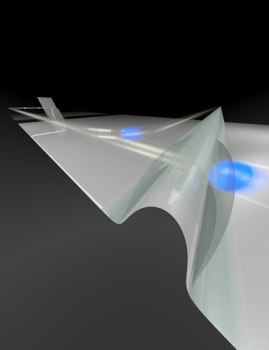Dec 5 2013
In principle, the strange features of quantum mechanics can be accessed using single electrons as carriers of quantum information. However, while electrons can be captured in solid-state electrostatic traps, it is difficult to control them or to discover what happens to them once they are released.
 "An artist's impression of the experiment: Individual electrons (blue) will cross a potential barrier (foreground) if they still have enough energy, and the barrier is low enough, when they arrive"
"An artist's impression of the experiment: Individual electrons (blue) will cross a potential barrier (foreground) if they still have enough energy, and the barrier is low enough, when they arrive"
Now, research from the National Physical Laboratory (NPL) has revealed key details about how electrons are ejected from a trap and demonstrated that the electrons can actually be detected relatively far from the source.
The new research, published in Physical Review Letters, places an electrically-controlled barrier into the path of the electrons ejected from the trap. The strength of the barrier can be varied and the electrons will only cross the barrier if they retain enough energy to do so.
Using this technique, NPL's Quantum Detection Group found that the electrons travel for many micrometres before they lose energy - a large distance when considering the small scale of the experiment.
NPL's Jonathan Fletcher, who worked on the project, said:
"At a crude level, it's like a ballistics experiment where you find out how much energy a bullet has by firing it at a target and seeing whether or not it penetrates. The difference is that in this case the whole experiment is tiny. Our 'catapult' is a quantum dot, the projectile is a single electron, and the 'target' is an electrically-controlled barrier whose strength we can vary."
By rapidly turning the barrier on and off at different times the scientists could also probe the electrons with very precise time resolution. This technique works because the electrons are actually forced out of the pump by a trigger signal, against which the blocking detector can be synchronised.
The flexibility and resolution of this system was revealed by a new trick which emerged during the measurements. Two electrons ejected from a doubly loaded trap could actually be split into different paths using either the small energy or ejection time difference.
The measurement techniques described in this research could be used to guide the design of electron pumps or as part of a future method of quantum information transport using electrons.
Read an article describing the research published by the American Physical Society http://physics.aps.org/articles/v6/127
Read the full paper published in Physical Review Letters: Clock-Controlled Emission of Single-Electron Wave Packets in a Solid-State Circuit http://prl.aps.org/abstract/PRL/v111/i21/e216807